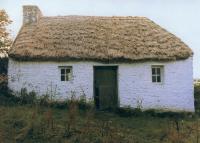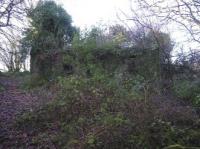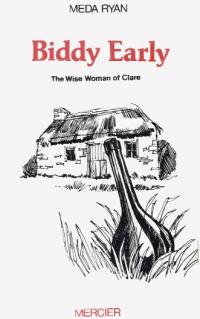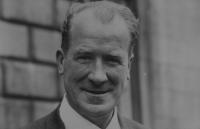Feakle’s Biddy Early: a victim of ‘moral panic’?
Published in 18th-19th Century Social Perspectives, 18th–19th - Century History, Features, Issue 1(Jan/Feb 2012), Volume 20
Biddy Early’s small, two-roomed cottage overlooking Kilbarron Lake in Feakle, Co. Clare, following renovation in the early 1970s. It fell back, however, into the state of ruin (inset) in which it lies today. (Tulla Library, Google Images)
Biddy Early died on the afternoon of 22 April 1874 in a small, two-roomed mud cottage overlooking Kilbarron Lake in Feakle, Co. Clare. Her life story was first published in 1903, with dark tales of witchcraft continuing to swirl around her memory ever since. In the 1970s an attempt to secure funding for a newly renovated cottage by Fianna Fáil TD Dr Bill Loughnane ended in failure, as no government agency would finance its upkeep. The building itself returned to the state of ruin in which it lies today. Indeed, its former owner was consigned to an unmarked grave.
The ‘magic bottle’
During her long life Biddy’s fame for cures made her a household name, and at some point she acquired a ‘blue’ or ‘black bottle’, which contained a dark, healing liquid. Although stories differ about how it came to be in her possession, all sources agree that its origin lay with the ‘fairies’. It was frequently used for the purposes of divining future events, a process known as ‘scrying’. Biddy also mixed herbal cures in this and other bottles in order to cure illness in animals as well as in people.
 The gathering of herbs and plants before sun-up with the morning dew still on them was reminiscent of the earlier alchemists, who regarded dew as being ‘a secretion from dawning light’—a key element of the ‘philosopher’s stone’, said to grant eternal life. In old age it is said that Biddy became cranky and absent-minded and this may have contributed to smears associating her with ‘witchcraft’. In reality, she appears to have been a generous woman who rarely accepted monetary payments (preferring instead gifts of food), but she was not to be scorned! While her home became a place of merriment, with neighbours frequently coming over ‘on cuaird’ (Biddy was known to have a plentiful supply of donated alcohol), over an eight-year period her joie de vivre led to conflict with local élites, including the Catholic Church, the medical profession, landlords, the police and judiciary.The area around Feakle was, in Biddy’s time, one of the most superstitious in Ireland. Pishogues of various types were employed then—and even today, occasionally—in order to bring bad luck to a neighbour. Indeed, it was common for ‘wise women’ (spéirbhean) to be sought out to help lift these curses from the poor. Disagreements with the fairies over the violation of their ancient land rights also required mediators with special powers—a task for which Biddy came well qualified. Indeed, it was said that she had spent some time in her youth living amongst the sidhe (fairies), and that she, her brother and her only son, Paddy, were in fact ‘away with the fairies’ and ‘changelings’.
The gathering of herbs and plants before sun-up with the morning dew still on them was reminiscent of the earlier alchemists, who regarded dew as being ‘a secretion from dawning light’—a key element of the ‘philosopher’s stone’, said to grant eternal life. In old age it is said that Biddy became cranky and absent-minded and this may have contributed to smears associating her with ‘witchcraft’. In reality, she appears to have been a generous woman who rarely accepted monetary payments (preferring instead gifts of food), but she was not to be scorned! While her home became a place of merriment, with neighbours frequently coming over ‘on cuaird’ (Biddy was known to have a plentiful supply of donated alcohol), over an eight-year period her joie de vivre led to conflict with local élites, including the Catholic Church, the medical profession, landlords, the police and judiciary.The area around Feakle was, in Biddy’s time, one of the most superstitious in Ireland. Pishogues of various types were employed then—and even today, occasionally—in order to bring bad luck to a neighbour. Indeed, it was common for ‘wise women’ (spéirbhean) to be sought out to help lift these curses from the poor. Disagreements with the fairies over the violation of their ancient land rights also required mediators with special powers—a task for which Biddy came well qualified. Indeed, it was said that she had spent some time in her youth living amongst the sidhe (fairies), and that she, her brother and her only son, Paddy, were in fact ‘away with the fairies’ and ‘changelings’.

Biddy Early’s ‘magic bottle’, as imagined on the cover of Meda Ryan’s Biddy Early—the wise woman of Clare. (Mercier Press, 1978)
In 1843 J.G. Kohl, a German writer touring the region, recorded that a number of ‘wise women’ lived in the area. He used the term ‘legislator’ to describe them. They were ‘Norisheen’, a clairvoyant and soothsayer who told of the interests of the country, ‘Consideen’ from Edenvale, who claimed to know death personally and the hour of her own death, and ‘Crohoor Highue’ who, 90 years before Biddy, could charm the very birds from the trees. Although these characters enjoyed legendary status, Biddy Early was destined to be the greatest of them all. Her reputation, however, was soon to become a double-edged sword.
Conflict with the Catholic Church and the medical profession
The Catholic Church in Ireland vehemently opposed all remnants of paganism, but its capacity in Penal times to oppose the likes of Biddy Early was severely restricted. Following Catholic Emancipation in 1829, however, the church slowly began to re-emerge as a power in the land. Confrontations with various clergymen thus formed the basis of many folktales surrounding Biddy. It is said, for example, that one fiery curate from County Tipperary who rode to the cottage to chastise her was frozen in his saddle near Annasala Bridge. After he recanted his diatribes, Biddy released him by picking three ‘thraneens’ (blades of dry grass) and telling an intermediary to strike the right shoulder of the curate’s horse with them ‘in the name of the Father and of the Son and of the Holy Ghost’. Biddy was always said to have thus invoked the Holy Trinity in any remedy she gave. Despite such incidents, she advised local people to listen to the advice of the clergy. Indeed, visitors to her cottage included Catholic champion Daniel O’Connell, who defeated political rival Vesey Fitzgerald by 982 votes in the 1828 Clare election.Conflict with medical science forms the basis of several stories associated with Biddy Early. At one time it was said that she rented a cottage from a Dr Murphy (or Dunne) from Limerick. He wanted her evicted for the non-payment of rent and/or professional jealousy. Five police officers and a sheriff, sent to evict her from the small cottage she occupied near Kilbarron Lake, were commanded by her to ‘Stay where you are’. The words were said to have been given to her in an apparition by her dead husband, Pat. The terrified men were rooted to the road for two hours before she released them. Such events may be explained by the power of auto-suggestion or even hypnosis. Stage performers like Derren Brown, for example, have made fortunes from similar tricks today.In another version of the tale, Biddy warned the men sent to evict her with the words, ‘Whoever will be the first to put a bar to the house, he’ll remember it’. One of the men put a crowbar between two stones in a wall but fell awkwardly as he did so, breaking his thigh. Taking their wounded colleague, the men ran off with their tails firmly between their legs.

Dr Bill Loughnane TD attempted, unsuccessfully, to secure funding for the renovated cottage in the early 1970s. An ancestor, Patrick Loughnane, was a neighbour of Biddy’s. (RTÉ Stills Library)
Dr Murphy was not long to be denied, though, and Biddy was forced into the Ennis ‘house of industry’. Strangely, the doctor’s own house in Limerick caught fire soon after, leaving only a charred foot to be taken from the ruins after he was trapped inside. Biddy Early was said to have warned him in advance of his fate. It was not to be her last run-in with the medical profession. A Dr Folan from Ennis came to argue with her but found that he could not find his way to her home, although he knew the road well. In fairness to Biddy Early, she did not guarantee a cure and she occasionally refused to see some patients if she felt that they were destined to die. She might even give a potion in a bottle to placate an anxious relative. According to legend, this would inevitably break if death was predestined. This element of predestination was seen also in the legends surrounding Moll Anthony, who lived near the Red Hills of County Kildare. Biddy’s other talents included advising local farmers about those stealing their cattle or sheep (sometimes by getting them to look in a ‘magic mirror’ she kept in her home) and resolving family disputes.

The victorious Clare hurlers of 1995, who finally laid the ‘curse of Biddy Early’ to rest. (Sportsfile)
Landlords, police and judiciary
The nineteenth century was a time of bitter agrarian violence in County Clare, when desperate men using names such as White Boys, Ribbonmen and Moonlighters sought brutal revenge for local evictions by the landlord class. On the Carheen estate of one landlord by the name of Sheehy, where Biddy was in service in 1816, a court order was issued for her eviction, following a petition organised against the raising of rents. Biddy warned the landlord that his bones would never lie in hallowed ground. Subsequently, three tenants led by a man called Touhy killed Sheehy and burned his house to the ground. Biddy was able to advise the men that a potential witness for the Crown, a woman called Nell Canny, should not be harmed, as she might prove useful to them. Subsequently, the same woman, who was a maid on the estate, told the court that it was she and not the accused who had dropped hot coals on the grass outside Touhy’s cottage. In a later case involving the shooting to death of Alderman William Sheehy—brother of the same man killed by the Touhy gang—Biddy advised ‘Mick the Moonlighter’ of a suitable escape route to America via Liscannor and Kilrush that would avoid the ‘Peelers’. Her then husband Tom Flannery (described in the local press as being the husband of Biddy Early ‘the witch’) was before the courts in 1860 for conspiracy in the same murder and lodged in Ennis gaol. Fortunately for him, given that the chief culprits had vanished, the case was dropped. It was said also that Biddy was tried for witchcraft in 1865 under a 1586 statute but this has never been proved. She certainly was not convicted of any offence.Before she died in April 1874 she asked or agreed to a request from neighbour Patrick Loughnane (a relative of Dr Bill Loughnane) to fetch a priest to give her the last rites. It was also said that she asked this same man (or the attending parish priest, Father Andrew Connellan) to throw her ‘magic bottle’ into what became known later as ‘Biddy’s lake’. It was a suitably Arthurian end for this larger-than-life character. According to one source, 27 priests were said to have attended her funeral, and the following Sunday the parish priest asked his parishioners to pray for the repose of the soul of Biddy Early, whom he described as a ‘saint’. As the old saying goes, ‘if you can’t beat them, join them’! HI
John Rainsford is a post-graduate student in the School of Languages, Literature, Culture and Communication at the University of Limerick.
Further reading:
E. Goode and N. Ben-Yehuda, Moral panics: the social construction of deviance (Oxford, 1994).E. Lenihan, In search of Biddy Early (Cork, 1987).M. Ryan, Biddy Early—wise woman of Clare (Cork, 1978).D. Stewart, ‘Biddy Early—famous “witch” of Clare’ (Parts I & II), Limerick Chronicle, 3 and 10 October 1953.
















